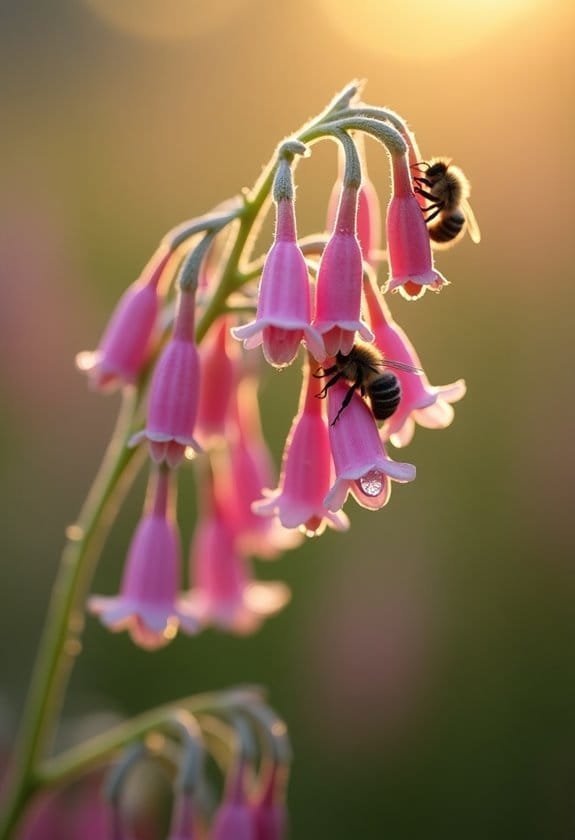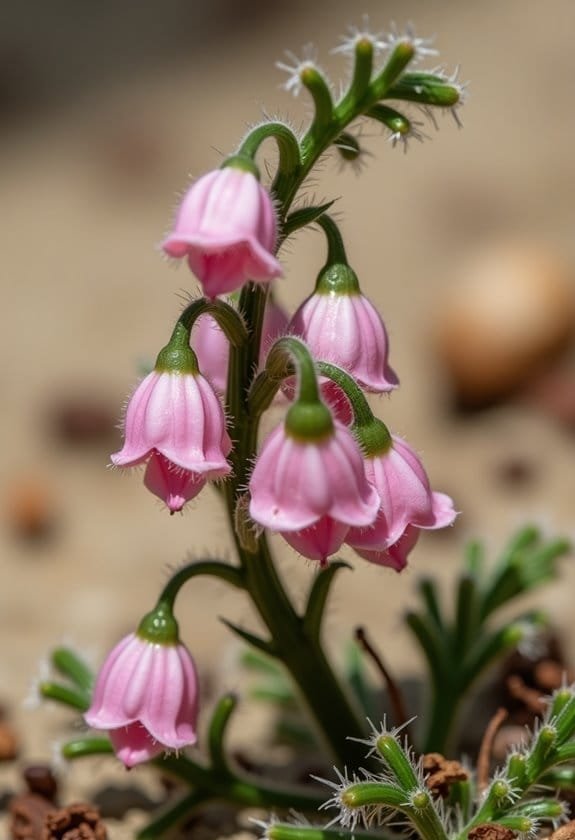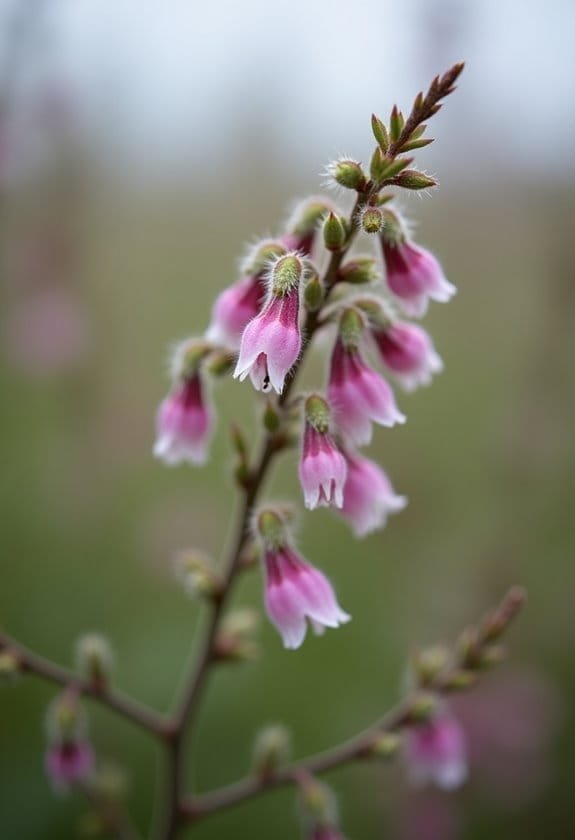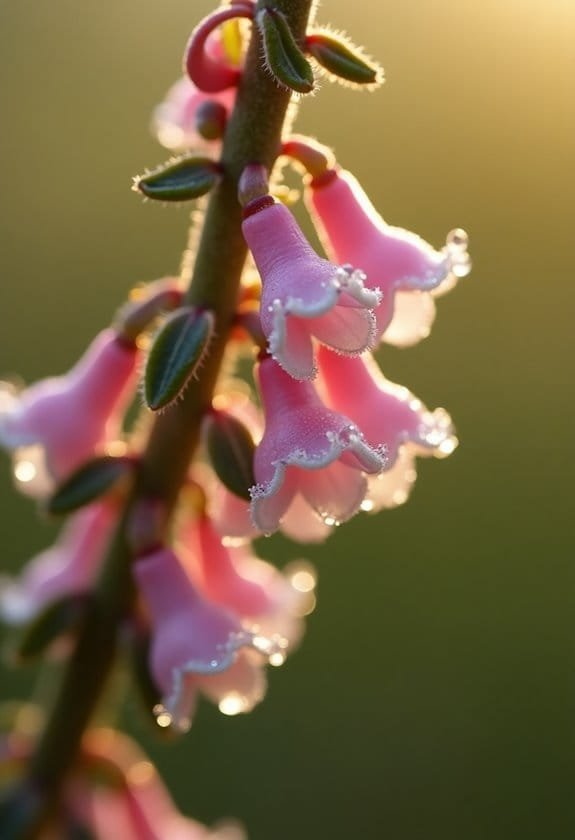The Dorset heath (Erica ciliaris) is a low-growing evergreen shrub that's prized for its delicate pink bell-shaped flowers and serves as Dorset's county flower. Standing 30-60 cm tall, it features distinctive needle-like leaves arranged in whorls and blooms extensively from June through December. This rare species thrives in acidic, moist soils and plays a crucial role in supporting local biodiversity, particularly as a nectar source for pollinators. It requires full sun exposure and consistent moisture to flourish, making it an integral component of heathland ecosystems. The plant's unique characteristics and ecological significance offer fascinating insights into specialized plant adaptations.
Main Points
- Dorset Heath is a low-growing evergreen shrub featuring pink bell-shaped flowers and needle-like leaves arranged in whorls.
- Designated as Dorset's county flower since 2002, this species thrives in acidic, moist soils and forms dense heathland communities.
- The plant flowers from June to December, producing nectar that supports local pollinators, especially bees.
- Regular trimming and full sun exposure are essential for optimal growth, along with consistently moist, well-draining acidic soil.
- Conservation efforts focus on protecting existing populations while implementing habitat management and community engagement programs.
Introduction

Dorset Heath (Erica ciliaris) stands as one of Britain's most distinctive heathland plants, featuring delicate pink bell-shaped flowers and needle-like leaves arranged in distinctive whorls.
This low-growing evergreen shrub reaches heights between 30 and 60 centimeters, creating a vibrant carpet across its native habitats in southern and western England.
Recognized as the county flower of Dorset since 2002, this resilient species plays an essential role in supporting local biodiversity while adapting to the challenging conditions of acidic, moist soils in its heathland environment.
Common Name
The native heathland plant Erica ciliaris is commonly known as Dorset Heath, a name that reflects its historical presence in the Dorset region of England. This distinctive name has become deeply intertwined with the region's natural heritage, highlighting the plant's significant role in local ecosystems and cultural identity.
The designation of Dorset Heath as the county's official flower in 2002 through a Plantlife poll further cemented its connection to the region's botanical legacy. This recognition acknowledges both its native distribution and its importance as a flagship species for local conservation efforts in southern England.
The common name serves as more than just a geographical identifier; it represents the plant's integral relationship with Dorset's characteristic heathland landscapes and acidic bog environments.
While Erica ciliaris can be found in other locations, its strong association with Dorset's natural areas has made it an emblematic species that symbolizes the region's commitment to preserving its unique botanical heritage and maintaining the delicate balance of its heathland ecosystems.
Scientific Name
Scientifically known as Erica ciliaris, this distinctive heathland species carries a name that reflects both its genus and specific characteristics. The species occurs within the extensive Ericaceae family, which encompasses numerous heath and heather varieties across the globe. Scientifically known as Erica ciliaris, this distinctive heathland species carries a name that reflects both its genus and specific characteristics. The species occurs within the extensive Ericaceae family, which encompasses numerous heath and heather varieties across the globe. Known for its vibrant pink flowers and ability to thrive in acidic soils, Erica ciliaris is an integral part of heathland ecosystems. Among crossleaved heath plant facts, it is notable for supporting biodiversity, providing habitat and nourishment for insects and small wildlife. Its adaptability to nutrient-poor conditions highlights its ecological importance in maintaining balance in challenging environments.
The scientific nomenclature provides valuable insights into the plant's distinctive features, particularly through its specific epithet "ciliaris," which alludes to the fine, hair-like structures found on its foliage. This taxonomic classification helps botanists and researchers accurately identify and study this vulnerable heathland species, which displays remarkable adaptations to its environment.
The plant's scientific identity aligns perfectly with its physical characteristics, as evidenced by its diminutive stature of 30 to 60 centimeters and its minute, needle-like leaves measuring just 2-4 millimeters in length.
These precise measurements, documented through scientific observation, contribute greatly to the species' formal identification and classification within the botanical community. Understanding its scientific designation becomes particularly essential for conservation efforts, as it enables accurate monitoring and protection of this important heathland species.
Overview
Along the rugged heathlands of southern England grows one of Britain's most distinctive heather species, Erica ciliaris, commonly known as Dorset Heath. This low-growing evergreen shrub, reaching heights between 30 and 60 centimeters, has become an integral part of the region's ecological tapestry, particularly in the counties of Dorset, Devon, and Cornwall.
The plant's delicate pink bell-shaped flowers emerge in late summer, creating a vibrant display that persists through early autumn and serves as a crucial nectar source for local pollinators.
Dorset Heath ecology centers around its presence in moist, acidic environments, where it forms dense communities that support diverse wildlife populations and contribute to the broader heathland ecosystem's stability.
As urbanization and environmental changes threaten these unique habitats, conservation strategies have become increasingly focused on protecting remaining Dorset Heath populations.
Current habitat restoration efforts concentrate on maintaining suitable soil conditions and managing competing vegetation, while researchers monitor the species' response to climate fluctuations and develop adaptive management techniques to guarantee its survival in Britain's changing landscape.
Key Features
Dorset Heath stands as a compact shrub reaching heights of 30 to 60 cm, adorned with fine needle-like leaves measuring just 2-4 mm in length.
The plant's most striking feature lies in its vibrant pink flowers, which form elongated clusters called racemes and measure 8-12 mm per bloom.
These distinctive flowers grace the plant from June through autumn's end, with peak blooming occurring during fall months when many other plants have ceased their floral displays.
Growth Size
This hardy heather's compact growth reaches heights between 30 to 60 cm (12 to 24 inches), featuring distinctive bell-shaped flowers that measure 8-12 mm in length. The plant exhibits trailing growth habits that require careful attention to maintain its intended size within garden settings.
The diminutive leaves, measuring just 2-4 mm in length, contribute to the plant's overall compact appearance while showcasing characteristic glandular hairs that distinguish it from other heather varieties. Throughout its active growing season, which extends from early summer through autumn, the plant's growth patterns demand strategic maintenance strategies to prevent excessive spread and maintain ideal height variations.
During its peak blooming period in fall, when many garden plants have ceased flowering, Dorset Heath's vibrant pink blooms create a striking display that belies its modest stature.
Gardeners must implement regular trimming protocols to manage the plant's natural trailing tendency, ensuring it maintains its desired form while allowing enough growth to support robust flower production. This balance between controlled growth and flowering potential makes Dorset Heath an excellent choice for structured garden designs.
Appearance
With its distinctive bright pink flowers and pale green foliage, Dorset Heath presents a striking visual display in natural and cultivated settings. The most prominent feature of this heathland species is its elongated racemes of vibrant pink blooms, which measure 8-12 mm in length and create spectacular color variations against the muted background of its preferred habitat.
The plant's foliage exhibits unique characteristics that distinguish it from other heath species. Its needle-like leaves, measuring just 2-4 mm, are adorned with distinctive glandular hairs that create a slightly sticky leaf texture, adding both visual and tactile interest to the plant. This adaptation enhances the plant's subtle charm while serving practical purposes in its native environment.
The flowering period showcases Dorset Heath's remarkable staying power, with blooms emerging in June and maintaining their aesthetic appeal well into December.
In its preferred habitat preferences of acidic, moisture-rich environments such as bogs and wet heaths, the plant's pale green foliage provides a complementary backdrop that emphasizes the beauty of its extended flowering display.
Flowering Season
Throughout summer and fall, the flowering season of Dorset Heath creates a spectacular display of pink blooms that persists from June through December. The flowering duration spans an impressive six months, with the plant reaching its full height of 30 to 60 centimeters during this extended blooming period.
The most remarkable display occurs during autumn, when the vibrant pink flowers, measuring 8 to 12 millimeters in length, stand out dramatically against the subdued colors of other fading vegetation.
These blooms are arranged in elongated racemes, creating elegant vertical displays that enhance the plant's ornamental value throughout the season. As seasonal changes progress, the Dorset Heath maintains its aesthetic appeal even as other plants enter dormancy.
The bloom colors remain attractive well into winter, though they gradually soften in intensity. This extended flowering period makes
Growing Requirements

Dorset Heath demands specific growing conditions to thrive, requiring full sun exposure and consistently moist, acidic soil with excellent drainage.
The plant's robust drought tolerance allows it to withstand periodic dry spells, though regular watering helps maintain its lush appearance and vigorous blooming cycle.
While adaptable to various conditions, this heather species needs protection from harsh winter temperatures below 10°F, making site selection essential for its long-term survival and ideal performance in the garden.
Light
Full sunlight is essential for Dorset Heath to thrive and reach its maximum potential. The plant's light adaptability allows it to flourish in open spaces where it can receive unobstructed sunlight exposure throughout the day, promoting robust growth and abundant flowering.
During its peak blooming season, which begins in June and continues through autumn, the plant capitalizes on increased daylight hours to produce its distinctive flowers.
While Dorset Heath demonstrates remarkable resilience to varying conditions, including periods of drought, ideal sunlight remains critical for maintaining its liveliness. The plant's relationship with seasonal variations becomes particularly evident during its extended flowering period, when proper light conditions enhance both bloom quantity and quality.
Strategic spring pruning plays an important role in maximizing the plant's access to sunlight, as removing older growth creates space for new shoots to emerge and receive direct light.
Gardeners should consider positioning Dorset Heath in locations that receive full sun while maintaining the acidic, moist soil conditions that complement its light requirements, creating an excellent environment for this adaptable heather species.
Soil
Successful cultivation of Dorset Heath hinges on providing the right soil conditions, particularly acidic and consistently moist ground that mimics its natural heathland habitat. The plant demonstrates a marked preference for sandy soil types that feature slightly impeded drainage, which helps maintain the delicate balance of moisture it requires for ideal growth.
While Dorset Heath has adapted to thrive in nutrient-poor environments, proper soil moisture management plays an essential role in its long-term success. The plant's remarkable ability to withstand periodic drought conditions suggests its root system has evolved to cope with fluctuating moisture levels, though consistent dampness remains ideal.
Sandy, acidic soils provide the perfect foundation, allowing excess water to drain while retaining enough moisture to support healthy growth.
Despite its tolerance for poor soil nutrients, regular spring pruning can help compensate for nutritional deficiencies by promoting new growth and maintaining plant vigor. This practice, combined with well-draining acidic soil conditions, creates an environment that closely resembles the plant's native heathland ecosystem, where it has naturally adapted to thrive in challenging conditions.
Water
In relation to watering requirements, Erica ciliaris needs consistent moisture throughout its growing season while maintaining good drainage to prevent waterlogging. Water conservation strategies should focus on maintaining a delicate balance between adequate hydration and avoiding oversaturation, particularly during the critical blooming period from June through autumn.
Effective moisture retention methods include applying a layer of organic mulch around the plant's base, which helps regulate soil temperature and minimize water loss through evaporation.
During periods of drought, implementing targeted irrigation techniques becomes essential, as the plant requires supplemental watering to maintain its vibrant blooming cycle. While Dorset Heath demonstrates some drought tolerance, sustained periods without adequate moisture can stress the plant, making it more susceptible to cold damage when temperatures approach 10°F.
Regular monitoring of soil moisture levels, especially following spring pruning when water absorption capacity is enhanced, helps guarantee ideal growing conditions. Gardeners should adjust their watering schedule based on seasonal variations, increasing frequency during hot, dry spells and reducing it during periods of natural rainfall.
Temperature
Temperature requirements for Dorset Heath directly influence its watering needs and overall significance. While this hardy plant demonstrates remarkable resilience to drought conditions, its sensitivity to temperature extremes becomes particularly evident during harsh winters, as it can sustain damage when temperatures plummet to around 10°F (-12°C).
The climate impact on Dorset Heath manifests most prominently through seasonal fluctuations, which necessitate careful attention to its growing conditions throughout the year. Despite its vulnerability to severe cold, this heather species exhibits a notable preference for warm, sunny locations that support its vigorous growth and abundant flowering patterns.
To mitigate the effects of winter stress, gardeners often implement protective measures and conduct thorough spring pruning sessions, which help rejuvenate plants affected by temperature variations. The plant's natural adaptation to heathland environments has equipped it with mechanisms to handle moderate temperature changes, though it performs best when provided with consistent growing conditions that mirror its native habitat.
Understanding these temperature requirements is vital for maintaining healthy specimens that can withstand environmental pressures while maintaining their ornamental appeal.
Pollinator Criteria
Dorset Heath serves as a vital nectar and pollen source for diverse pollinators, particularly benefiting native bee populations during the extended flowering period from June through autumn.
The plant's vibrant pink, tubular flowers act as natural beacons for pollinating insects, offering essential sustenance when many other garden plants have ceased blooming.
Its recognition in the RHS Plants for Pollinators program underscores its significance in supporting ecosystem health and biodiversity through enhanced pollination services across garden landscapes.
Attracted Pollinators
Many pollinating insects are drawn to Erica ciliaris, making it an essential source of nectar and pollen in garden ecosystems. The plant's pollinator preferences primarily center around various bee species, which demonstrate a particular affinity for its tubular pink flowers during late summer and early autumn blooming periods.
The Royal Horticultural Society has recognized Dorset Heath's significant contribution to pollinator support through its inclusion in the Plants for Pollinators initiative. Nectar availability reaches its peak during the critical foraging months when many pollinator species are actively seeking sustenance, creating an invaluable food source for local wildlife populations.
The timing of its bloom cycle strategically aligns with periods of heightened bee diversity and activity.
The plant's ecological value extends beyond mere sustenance, as it serves as an essential component in maintaining healthy pollinator populations within garden environments. By incorporating Dorset Heath into designed landscapes, gardeners actively contribute to the preservation of pollinator habitats while fostering biodiversity through the attraction of various beneficial insects that depend on its resources.
Pollination Method
The pollination process of Erica ciliaris relies on specific adaptations that facilitate successful reproduction. The plant's pollination strategies center around its distinctive flower morphology, featuring large, vibrant pink blooms that serve as beacons for potential pollinators during the critical late summer to early autumn period.
The plant employs sophisticated nectar rewards to attract and maintain relationships with its primary pollinators, particularly various bee species. These insects are drawn to the flowers' specialized structure, which has evolved to guarantee ideal pollen transfer while the pollinators collect their sweet reward.
The timing of nectar production coincides with peak pollinator activity, maximizing the chances of successful cross-pollination between different Dorset Heath plants. This carefully orchestrated pollination method contributes greatly to the plant's genetic diversity and overall population health.
The RHS Plants for Pollinators initiative recognizes this intricate relationship, highlighting how the plant's pollination mechanism not only guarantees its own survival but also supports the broader heathland ecosystem by providing essential resources for pollinator communities throughout its blooming season.
Care & Maintenance

Successful cultivation of Dorset Heath begins with strategic placement in well-draining, acidic soil and full sun exposure to establish strong root systems.
Maintaining the plant's health requires annual pruning in spring, which stimulates vigorous growth and prevents the trailing stems from becoming unwieldy among garden companions.
Gardeners should pair this heather with other acid-loving plants such as rhododendrons and azaleas, while monitoring soil moisture levels to guarantee ideal growing conditions throughout the seasons.
Planting Tips
Gardeners seeking to grow Dorset Heath should focus on creating ideal growing conditions from the start. The planting methods for this species require careful soil preparation, with an emphasis on achieving the right balance of acidity and moisture retention.
When selecting a planting location, gardeners should prioritize areas that receive abundant sunlight while maintaining proper drainage characteristics.
For successful establishment, soil preparation involves incorporating organic matter and ensuring a pH level between 4.5 and 6.0. Companion planting with other acid-loving plants, such as rhododendrons or camellias, can create an aesthetically pleasing and environmentally harmonious garden space.
When placing multiple Dorset Heath plants, spacing them 18-24 inches apart allows for their natural trailing growth habit without overcrowding.
The planting hole should be twice the width of the root ball and at the same depth as the container, ensuring the crown sits slightly above soil level.
After planting, apply a 2-inch layer of acidic mulch, such as pine needles or bark, to retain moisture and suppress weed growth while maintaining ideal soil conditions for this distinctive heather variety.
Ongoing Care
Maintaining Dorset Heath's vibrancy extends well beyond initial planting efforts. This resilient heather species requires systematic care through carefully implemented pruning techniques and consistent moisture management to guarantee ideal growth and flowering performance.
Annual maintenance begins with thorough spring pruning, which serves as a rejuvenating process that stimulates robust new growth and enhances the plant's flowering potential.
Seasonal monitoring becomes particularly important as the blooming cycle initiates in June, continuing through to December's winter gardens. The plant's trailing growth pattern necessitates regular thinning to prevent overcrowding and maintain its desired height within garden spaces.
For successful cultivation, gardeners must pay special attention to moisture levels in the acidic soil, as proper hydration directly influences both vegetative growth and flower production.
A detailed care routine includes monitoring sun exposure, as Dorset Heath thrives in locations with abundant natural light.
Through disciplined pruning schedules and attentive moisture management, these distinctive plants will reward gardeners with extended blooming periods and maintain their characteristic compact form throughout the growing season.
Suggested Companions
For ideal growth and visual appeal, Dorset Heath thrives alongside carefully selected companion plants that share its cultural requirements. The most successful companion plantings include fellow heathland species like Erica tetralix (cross-leaved heath) and Calluna vulgaris (common heather), which create a tapestry of complementary textures and colors while promoting ecological diversity.
When planning garden aesthetics, it's vital to take into account the moisture and soil acidity requirements that these companions share with Dorset Heath. The selected plants should demonstrate similar drought tolerance once established, creating a resilient and sustainable planting scheme.
Regular maintenance, including strategic pruning of both Dorset Heath and its companion species, helps maintain best growing conditions and prevents any single species from dominating the space.
Height management plays an important role in companion selection, as taller species might overshadow Dorset Heath and impede its growth. The ideal arrangement positions plants of similar stature together, allowing each specimen to receive adequate sunlight while creating a harmonious visual display that mimics natural heathland communities.
How Does the Cornflower Compare to the Dorset Heath in Its Habitat Needs?
The centaurea cyanus flower thrives in open, sunny fields with well-drained, nutrient-poor soils, making it well-suited to farmland and meadows. In contrast, the Dorset Heath prefers acidic, moist, and nutrient-rich environments, often found in heathlands. These differing habitat needs highlight the unique ecological niches of these distinct and fascinating plants.
Common Issues
Dorset Heath can face several pest and disease challenges, including root rot from overwatering and damage from sap-sucking insects like spider mites and aphids.
The plant's vulnerability to fungal infections increases during periods of high humidity and poor air circulation, particularly when grown in cultivation rather than its natural habitat.
Effective solutions include maintaining proper spacing between plants, implementing good drainage systems, and using organic pest control methods such as neem oil or introducing beneficial predatory insects.
Pests/Diseases
Like many heaths, Erica ciliaris faces several important pest and disease challenges that can impact its health and survival. Root rot poses a particularly serious threat when soil conditions become waterlogged, potentially compromising the plant's entire root system and leading to rapid decline.
Among the most troublesome pests, aphids frequently target the plant's tender foliage, while destructive weevils can cause extensive damage by feeding on its roots. These pest infestations often require targeted pest management strategies, including regular monitoring and timely intervention with organic treatment options such as neem oil or beneficial insects.
Disease prevention techniques play an essential role in protecting Dorset Heath, especially against fungal infections like powdery mildew, which thrives in humid conditions. This persistent pathogen manifests as a distinctive white coating on leaves and flowers, potentially inhibiting photosynthesis and stunting growth.
Maintaining proper air circulation, avoiding overhead watering, and implementing appropriate spacing between plants can greatly reduce the risk of fungal diseases while promoting overall plant vigor.
Solutions
Addressing common issues affecting Dorset Heath requires a multi-faceted approach that combines habitat protection with active management strategies.
Conservation experts have developed thorough solutions that focus on preserving existing populations while expanding into suitable new areas through habitat restoration projects.
A key component involves implementing invasive species management programs, where trained teams regularly monitor and remove non-native plants that threaten to overwhelm Dorset Heath communities.
These efforts are complemented by careful climate adaptation strategies, including the creation of buffer zones and wildlife corridors that allow species movement in response to changing conditions.
Community engagement plays a crucial role in long-term conservation success, with local organizations partnering with landowners to establish protected areas and management agreements.
Educational initiatives help raise awareness about the ecological importance of heathland habitats, while citizen science programs enable volunteers to participate in monitoring efforts.
Additionally, researchers are developing innovative propagation techniques to strengthen existing populations, ensuring that future generations can continue to enjoy these unique ecosystems.
Summary

This distinctive heathland species, Erica ciliaris, is a small evergreen shrub native to South and West England. Growing to heights between 30 and 60 centimeters, Dorset Heath is characterized by its delicate needle-like leaves arranged in whorls and enchanting bell-shaped flowers that paint the landscape in shades of pink and purple during late summer.
The plant's ecological significance extends far beyond its aesthetic appeal, serving as a essential component of heathland ecosystems and providing necessary habitat for diverse wildlife species.
Like a natural beacon for pollinators, particularly bees, Dorset Heath contributes considerably to local biodiversity and ecosystem health. However, this vulnerable species faces mounting challenges from habitat loss, invasive competitors, and climate change impacts.
Conservation strategies have become increasingly important for protecting remaining populations of Dorset Heath, with habitat protection measures at the forefront of preservation efforts.
Through dedicated conservation initiatives and public education programs, stakeholders are working to guarantee this remarkable species continues to thrive in its native range, maintaining its role as a cornerstone of British heathland biodiversity.


